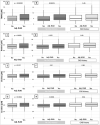Gut microbiota-dependent metabolite trimethylamine N-oxide (TMAO) and cardiovascular risk in patients with suspected functionally relevant coronary artery disease (fCAD)
- PMID: 35220448
- PMCID: PMC9151506
- DOI: 10.1007/s00392-022-01992-6
Gut microbiota-dependent metabolite trimethylamine N-oxide (TMAO) and cardiovascular risk in patients with suspected functionally relevant coronary artery disease (fCAD)
Abstract
Background: Trimethylamine N-oxide (TMAO) has been associated with cardiovascular outcomes. However, the diagnostic value of TMAO and its precursors have not been assessed for functionally relevant coronary artery disease (fCAD) and its prognostic potential in this setting needs to be evaluated.
Methods: Among 1726 patients with suspected fCAD serum TMAO, and its precursors betaine, choline and carnitine, were quantified using liquid chromatography tandem mass spectrometry. Diagnosis of fCAD was performed by myocardial perfusion single photon emission tomography (MPI-SPECT) and coronary angiography blinded to marker concentrations. Incident all-cause death, cardiovascular death (CVD) and myocardial infarction (MI) were assessed during 5-years follow-up.
Results: Concentrations of TMAO, betaine, choline and carnitine were significantly higher in patients with fCAD versus those without (TMAO 5.33 μM vs 4.66 μM, p < 0.001); however, diagnostic accuracy was low (TMAO area under the receiver operating curve [AUC]: 0.56, 95% CI [0.53-0.59], p < 0.001). In prognostic analyses, TMAO, choline and carnitine above the median were associated with significantly (p < 0.001 for all) higher cumulative events for death and CVD during 5-years follow-up. TMAO remained a significant predictor for death and CVD even in full models adjusted for renal function (HR = 1.58 (1.16, 2.14), p = 0.003; HR = 1.66 [1.07, 2.59], p = 0.025). Prognostic discriminative accuracy for TMAO was good and robust for death and CVD (2-years AUC for CVD 0.73, 95% CI [0.65-0.80]).
Conclusion: TMAO and its precursors, betaine, choline and carnitine were significantly associated with fCAD, but with limited diagnostic value. TMAO was a strong predictor for incident death and CVD in patients with suspected fCAD.
Clinical trial registration: NCT01838148.
Keywords: Cardiovascular death; Functionally relevant coronary artery disease (fCAD); Gut microbiota; Incident major adverse cardiac events (mace); Myocardial infarction; Trimethylamine N-oxide (TMAO).
© 2022. The Author(s).
Conflict of interest statement
Dr. Walter reports a research grant from the Swiss Academy of Medical Sciences and the Bangerter Foundation (YTCR 23/17). Dr. Twerenbold reports receiving research support from the Swiss National Science Foundation (P300PB_167803), the Swiss Heart Foundation, the Swiss Society of Cardiology, the University Hospital of Basel, as well as speaker honoraria/consulting honoraria from Roche Diagnostics, Abbott Diagnostics, Siemens, Singulex and Brahms. Dr. Nestelberger received speaker honoraria from Beckman-Coulter. Dr. Koechlin has received a research grant from the University of Basel, the Swiss Academy of Medical Sciences and the Gottfried and Julia Bangerter-Rhyner Foundation, as well as the “Freiwillige Akademische Gesellschaft Basel”, outside the submitted work. Professor Mueller reports receiving research support from the Swiss National Science Foundation, the Swiss Heart Foundation, the KTI, the European Union, the Stiftung für kardiovaskuläre Forschung Basel, the University of Basel, the University Hospital Basel, Abbott, Beckman Coulter, Biomerieux, Brahms, Ortho Diagnostics, Roche, Siemens, Singulex, Sphingotec, as well as speaker honoraria/consulting honoraria from Abbott, Amgen, Astra Zeneca, Biomerieux, Boehringer Ingelheim, BMS, Brahms, Cardiorentis, Novartis, Roche, Sanofi, Siemens, and Singulex. Professor Hazen and Professor Wang were supported in part by grants from the National Institutes of Health and the Office of Dietary Supplements (P01HL147823, HL103866, HL126827, HL130819 and the Leducq Foundation). Mass spectrometry studies were performed on instruments housed in a facility supported in part by a Center of Excellence Award by Shimadzu Scientific Instruments. Professor Hazen and Professor Wang report being named as co-inventor on pending and issued patents held by the Cleveland Clinic relating to cardiovascular diagnostics and therapeutics and being eligible to receive royalty payments for inventions or discoveries related to cardiovascular diagnostics or therapeutics from Cleveland HeartLab, Quest Diagnostics, and Procter & Gamble. SL Hazen also reports being a paid consultant for Procter & Gamble and having received research funds from Procter & Gamble and Roche Diagnostics.
Figures



References
Publication types
MeSH terms
Substances
Associated data
Grants and funding
LinkOut - more resources
Full Text Sources
Medical

